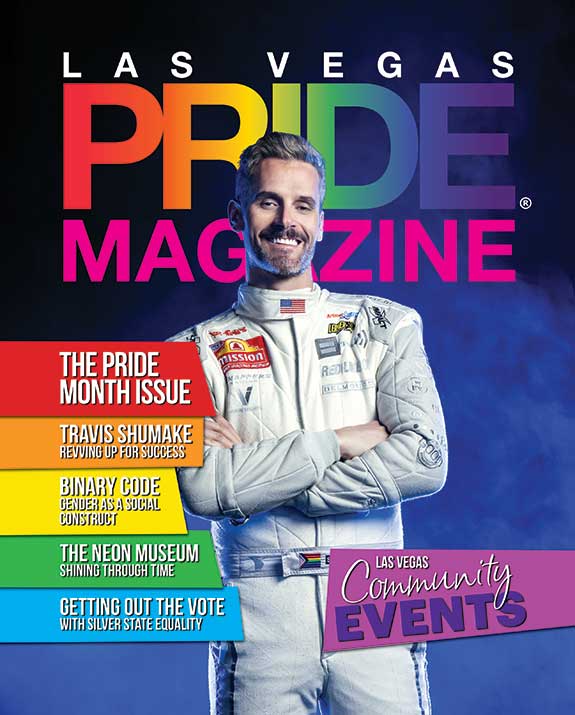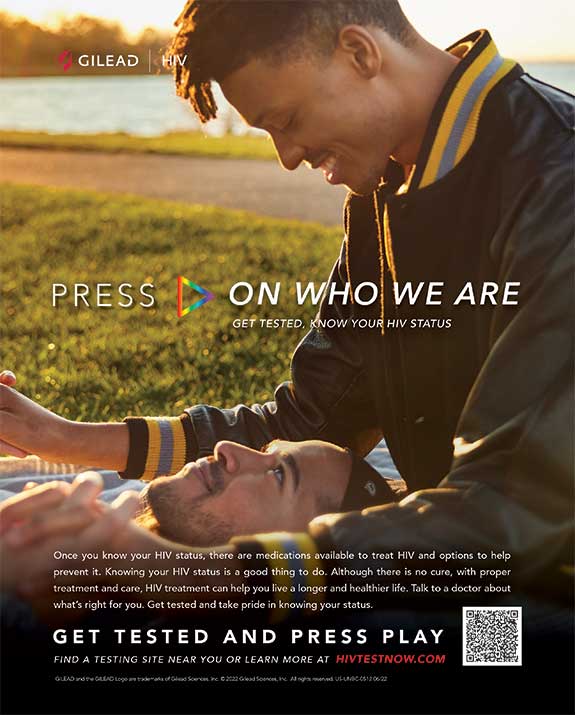Exclusively Inclusive.
By Karen Brain
Happy Pride Month to everyone! Do you celebrate Pride? If so, do you know why? Do you know its history? Do you know there are different kinds of Prides?
As a kid, I felt a strong connection with my gay friends. The more I learned about their experiences and interests, the more I realized how much we had in common. The larger my circle of LGBTQ+ friends grew, the more I realized how much the LGBTQ+ and Disability communities have in common.
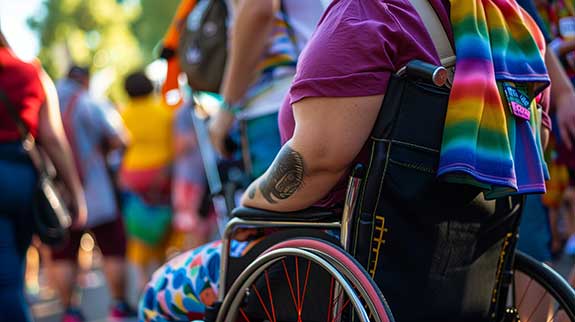
Sure, my small sample size did not represent either community entirely, but the apparent overlap was surprising. Growing up feeling different from everyone around us, including our own family members? Check. Feeling judged and told our difference was wrong? Check. Dreaming of growing old with the love of our life? Check. Love of Madonna, Club Kids culture, and all things glitter and rainbows? Check, check, and check.
I still find it fascinating how common it is for people to assume my sexual orientation because I have gay friends (or because I write for this magazine). I’ve always wondered, do people assume my friends and relatives are disabled because they’re seen with me?
By the time I was in my 20s and discovered LGBTQ+ Pride, I was celebrating it with my friends, and it was the most fun I’d ever had! There was dancing with the best music, a parade and festival, beaded necklaces, sometimes bubbles and foam, and OMG, so much glitter and rainbows, what’s not to love?! Ok, portable toilets. I don’t love those. But if you asked me then if I knew how Pride started, my answer would be no. I don’t remember talking about that with my friends. I didn’t know there were other types of Pride either.
June is LGBTQ+ Pride Month, and June 28 is LGBTQ+ Pride Day, based on the Stonewall Revolt in 1969 in the Stonewall Inn Bar in the Greenwich Village neighborhood, New York, which led to a series of riots. This is known as the catalyst for the LGBTQ+ rights movement in other countries as well as in the United States. I encourage you to research this history if you don’t know about it.
July is Disability Pride Month, based on the Americans with Disabilities Act (ADA), which was signed on July 26, 1990. The Disability Pride flag has parallel color stripes: red for physical, gold for cognitive and intellectual, white for nonvisible and undiagnosed, blue for psychiatric, and green for sensory disabilities. The flag’s black background mourns people with disabilities who have died due to negligence, suicide, rebellion, illness, and eugenics.
Like LGBTQ+ Pride, Disability Pride is about self-affirmation, dignity, equity, and increased visibility. It’s about creating spaces where we can be our authentic selves and celebrate it together. It is celebrated internationally with parades, too. As far as I know, my hometown, San Diego, does not have a Disability Pride parade. But we do have the LGBTQ+ Pride parade during July, so it’s like a two-fer for me.
It seems to me the Civil Rights Movement was the forerunner of Pride. Historically, a U.S. social movement and campaign to abolish legalized racial segregation, discrimination, and disenfranchisement. But I think we can agree the work is far from finished in this country. To me, this movement’s actions teach us the importance of equity and justice, and that anything less than that is unacceptable. It demonstrates how to communicate this through grassroots protests, nonviolent resistance, and civil disobedience campaigns. Furthermore, when we join together and work as a team, we find solutions and successes more quickly. For example, this could be due to the group size (e.g., massive group drawing the media’s attention), the group’s diversity (pooling knowledge, skills, and resources), and recognizing the commonality of the cause (mutual respect, “I see you,” listening to and learning from each other’s experiences).
Disability Pride is built upon the Social Model of Disability as opposed to the Medical Model of Disability. The Social Model of Disability was developed in the 1970s, and it is a belief that “disability” is caused by society rather than by a person’s differences. Meaning that it is society’s attitudes, prejudices, and discriminations, the physical structures and ways society is organized, creating barriers for us; this is what makes us “disabled.” I find explaining disability-related terms and topics to others most helpful by applying them to my audience’s identities. To apply this model’s definition to various populations, the Social Model believes there is no problem with the LGBTQ+/person of color/disabled; the problem lies with society’s attitudes, prejudices, discriminations, and barriers for us.
Whereas the Medical Model of Disability is the belief that the person’s difference/disability (or someone perceived to be disabled) is something needing to be fixed, our difference should be cured, and in some cases, could only be cured with the help of an outside force. The able-body or “typical abilities” are superior. To apply this model’s definition to various populations: the Medical Model believes that LGBTQ+/people of color/disabled need to be fixed because there’s something wrong with us; the straight/cisgender/white/able-bodied people are superior. “This framework, which is still embedded in modern approaches to healthcare and education, frames an individual’s disability as the cause for their inability to participate fully in society.”
I was diagnosed with my physical disability at 1-½ years old. I remember, at the age of 5, thinking, “If I can run fast enough, maybe those kids [from my class] won’t know [I’m disabled], and they’ll like me.” I knew I was different from my peers, I knew I was disabled, and I knew it was not ok. I was five years old and thought it was better to be closeted or to cover up my disability than to be authentic. That’s not something I learned from any one person, place, or behavior. That is something I learned from living every day in a world that believes, with direct and indirect messaging and barriers everywhere, that people like me are inferior, wrong, and need to be fixed, and if I can hide it, I should. A message so prevalent and clear that a five-year-old absorbed it in just a few years.
Like the direct messages from my Kindergarten teacher. She yelled and ostracized me in front of my peers because I could not sit on the floor due to my disability. She made me sit in a chair alone in the back of the classroom, where I sat crying while the rest of the class sat with her on the carpet, participating in activities together. She’d say, “If you can’t sit on the floor with the rest of us and participate, then you can sit in the back of the room and wait for us to finish the activities.” Thanks to my mother and the Section 504 Sit-Ins (Google it), my Individualized Education Program (IEP) started, and I was able to sit in a chair on the carpet with the rest of the class after all. Seems like a simple solution, right? So why did we have to fight so hard to accomplish it? But the school would not allow me to change Kindergarten teachers, as my mother requested. We’re not sure why they would not accommodate that request. But I am sure what message that taught me, as a five-year-old continuing to face that person of authority who did not hide her negative feelings about me each day. Also, I wonder what it taught my five-year-old peers about people with disabilities.
If you have not watched the movie Crip Camp: A Disability Revolution on Netflix or YouTube, please watch it as soon as possible. This movie is brilliant! It makes so many great points. I loved when Lionel Je’Woodyard talked about what he learned working with people with disabilities in New York and bringing it back to his small hometown; also comparing what he learned from people with disabilities about their life experiences and comparing it to his experiences as a person of color. I also loved learning from those who participated in the longest-lasting and most famous Section 504 Sit-In at the Department of Health, Education, and Welfare office in San Francisco. The benefits of a large, diverse group of protesters: when authorities turned phones off, protesters used American Sign Language (ASL) to communicate; the LGBTQ+ community contributed services like hair washing to the disabled protesters; and when the Black Panther supporters were asked why they brought food to protesters when their resources were already so limited, they responded, “You are trying to make the world a better place, and that is what we are about. We are about making the world a better place for everybody. So if you’re going to the trouble to stay here and sleep on the floor, we’re going to make sure you get fed.”
The movie also addressed the Capitol Crawl protest on March 12, 1990, when over 1,000 people marched from the White House to the Capitol building to demand Congress pass the ADA. When they arrived at the Capitol, protesters discarded their wheelchairs and mobility equipment. They crawled up the Capitol building’s stairs as a physical demonstration of how inaccessible architecture impacts people with disabilities. The youngest participant was 8-year-old Jennifer Keelan-Chaffins, who said during her crawl, “I will climb all night if I have to.” (You can also read about Jennifer’s true story in the children’s book “All the Way to the Top: How One Girl’s Fight for Americans with Disabilities Changed Everything.”) The media covered this amazing event, and the ADA was signed that July.
Towards the end of the movie, Denise Sherer Jacobson said, “You can pass a law, but until you change society’s attitudes, that law won’t mean much.” I hope this movie will be utilized to educate audiences on disability awareness, history, equity, and inclusion issues. In a world where ableism is so pervasive, we need more allies.
I wouldn’t want my friends, loved ones, or anyone to experience racism, homophobia, or any type of hate. What kind of a role model would I be to children or anyone else to allow such hate in my presence? I remember the day it finally occurred to me: Why could I fiercely defend friends and strangers, but blatant ableism in my face didn’t occur to me? Why did I not speak up for myself and those like me? It fascinates me how slow my own process has been to learn disability awareness, culture, empowerment, advocacy, and intolerance for ableism.
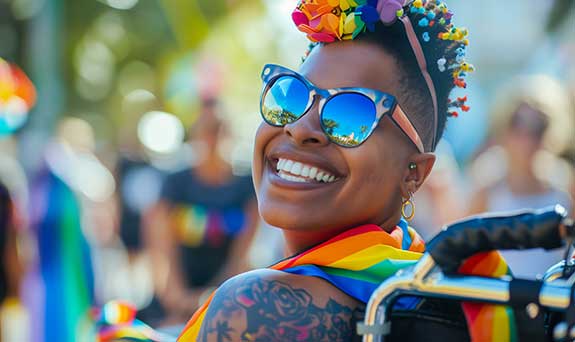
Now, every day, I’m able to fight my disease. I agree to fight ableism and fight for all communities who have been told their difference is wrong or inferior. Every day I’m alive, I can try to learn and educate. If I can use my privileges to help communities, so can you. I don’t have to be a person of color to know racism is wrong, and I need to fight against it. You don’t have to be disabled to ask why that person is parked in an accessible/blue parking space without displaying a valid placard or vehicle plates, or why building updates include another staircase instead of a ramp or elevator. Recognize that we are all family and need to help each other. Remember: when we join together and work as a team, we find solutions and successes quicker. I implore you to put your privileges to good use. Like MLK said, “Injustice anywhere is a threat to justice everywhere. Whatever affects one directly affects all indirectly. The time is always right to do what is right.”
This Pride Month and every Pride, let’s celebrate for all of us. For everyone who has been made to feel inferior. Those who have been told their differences are anything less than beautiful and correct. For those who came before us, those who died, and all of us now who continue to fight, advocate, and educate every day. WE ARE ALL FAMILY. Let’s dance if/however we feel comfortable. I’ll bring the glitter. You bring the rainbows.
This article was originally published in the 2024 PRIDE Month Issue of Las Vegas PRIDE Magazine, and can be read in its original format here.
